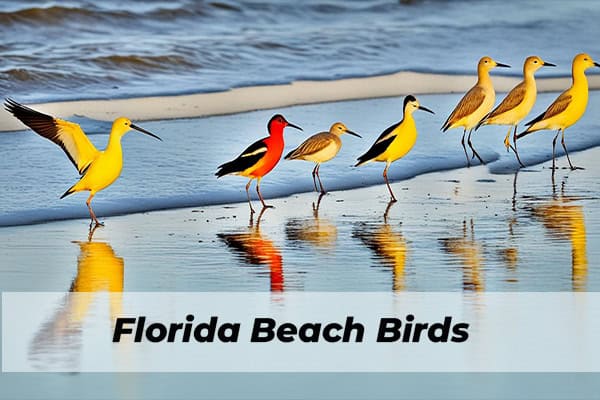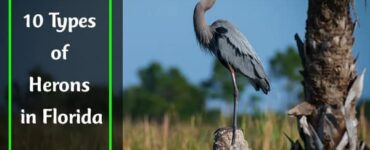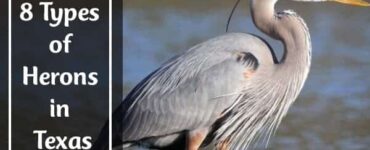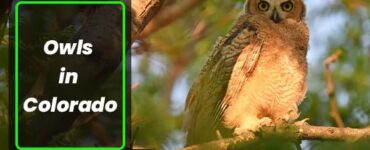Ever enjoyed the sight of Florida Coast Beach Birds? Florida’s stunning beaches attract people worldwide. Long before humans arrived, birds fell in love with these sandy havens. It’s a meeting spot for thousands of bird species. They come here to eat, breed, and find shelter. The famous Florida beach birds include the Greater Flamingo, Brown Pelican, Roseate Spoonbill, Oystercatcher, Laughing Gull, Black-Bellied Plover, Long-Billed Dowitcher, Snowy Egret, Black-Necked Stilt, Sanderling, Royal Tern, and Black Skimmer. You can spot these majestic birds at the water’s edge, on the beach, or within Florida’s lush landscapes. Curious about these birds’ uniqueness? Stick around to explore the richness, appeal, and intriguing behaviors of Florida’s top 10 beach birds.
Introduction to Florida Beach Birds
Florida is known for its stunning coastal birds. These birds make the state’s beautiful beaches their home. You’ll see many different kinds, from gulls and terns to herons and pelicans.
Diversity and Beauty of Coastal Avian Species
Florida’s coastal birds are truly amazing. They vary in shape, size, and color, but all are adapted for the coast. They bring beauty to the beaches.

Popular Beach Destinations for Bird Watching
If you love watching birds, Florida has top spots. Visit Gulf Islands National Seashore, or Honeymoon Island State Park. You can also go to Fort De Soto County Park, Fort Clinch State Park, and many others.
Graceful Gulls and Acrobatic Terns
Gulls are a common sight on Florida’s beaches. Among them are the distinctive laughing gulls with a black head and red bill. Larger herring gulls have a white head and a more massive frame. The small ring-billed gull is easily spotted by the black ring on its yellow bill. Terns, looking gull-like but lighter, soar above the waves. The Royal tern features an orange bill. And the Caspian tern boasts a blood-red bill. These birds are skilled at fishing, diving elegantly to catch their prey.
1. Laughing Gulls: Black Head and Red Bill
The laughing gull is easily seen along Florida’s coasts. It’s named for its laugh-like call, which fills the air at the beach.
2. Herring Gulls: Larger with White Head
The herring gull is significantly larger and has a white head. Its gray back and wings stand out. These gulls are good at finding food on the shore or in the water.
3. Ring-billed Gull: Black Ring on Yellow Bill
The ring-billed gull is smaller and stands out with its black-ringed yellow bill. They often fly gracefully over Florida’s waves.
4. Royal Tern: Orange Bill and Sleek Body
The impressive royal tern features an orange bill. It has a sleek form and is known for its diving prowess to catch fish.
5. Caspian Tern: Blood-Red Bill
The majestic Caspian tern is known for its large, blood-red bill. It hunts fish by diving dramatically into the water.
Shorebirds: Sanderlings, Dowitchers, and Willets
Shorebirds like sanderlings, dowitchers, and willets are common on Florida’s beaches. Sanderlings are among the smallest, with a sleek design. They have a black bill, dark eyes, and quick black legs. You’ll see them dashing away from waves.
6. Sanderlings: Small and Speedy
Sanderlings are pint-sized and known for their speed. They dash in and out of waves looking for snacks. Their quick moves while hunting on the sand are fun to watch.
7. Dowitchers: Long, Thin Bills in Flocks
Dowitchers are bigger and have a special long, thin bill for finding food in the sand. They often gather in small groups, blending in with their sandy surroundings. Looking closely, you’ll notice their organized feeding routines.
8. Willets: Large Shorebirds with Gray Bodies
Willets are one of the biggest Florida beach birds. They have a long bill, long legs, and a gray body. Their wide, round wings and short tails are distinct. You’ll see them moving slowly, hunting for various prey.
These birds come in many sizes and shapes. They add a lot of life to Florida’s coast. From quick sanderlings to methodical dowitchers, and the calm willets. Bird watchers and nature lovers find them all fascinating.
Florida Beach Birds: Iconic Coastal Avian Species
Florida is home to many iconic coastal bird species. They are known across the state’s beaches. The roseate spoonbill stands out. It’s bright pink with a unique spoon-shaped bill. The white ibis, with its white and red looks, is also eye-catching.
9. Roseate Spoonbill
The roseate spoonbill catches the eye with its pink feathers and odd bill. It’s often in Florida’s shallow waters, looking for food. This includes small fish, crustaceans, and invertebrates.
10. White Ibis
The white ibis is known for its white look and bright red face. It hunts for crabs and small sea creatures with its unique bill. You can often see it in Florida’s coastal areas.
11. Black Skimmer
The black skimmer has a black and white body and a unique bill. Its lower mandible helps it catch fish by skimming the water’s surface.
12. Oystercatcher
The oystercatcher has a standout black-and-white look with a long orange bill. It’s found on Florida’s beaches. These birds feed on shellfish, using their bills to pry them open.
13. Brown Pelican
The majestic brown pelican is a common sight on Florida’s coast. It’s large with a big bill and a pouch. They dive into the water to catch fish.
Nesting and Conservation Efforts
Florida’s beaches are crucial habitats for beach-nesting birds like terns and shorebirds. They lay their eggs in the soft sand, which makes the nests hard to see. Protecting these nests from predators is very important for conservation efforts.
Beach Nesting Areas for Terns and Shorebirds
The sandy beaches of Florida are home to many terns and shorebirds. The endangered Least Tern, for example, nests on these beaches. Yet, their homes are often disturbed by people, development, and rising sea levels. Organizations like Audubon Florida work hard to find and protect these nesting spots. They often put fences up to keep people away and protect the birds.
Protecting Eggs and Hatchlings from Predators
After laying eggs, beach-nesting birds face the challenge of keeping them safe. Many predators, like raccoons and foxes, threaten the eggs and young chicks. Audubon’s teams and volunteers watch over the nests. They also teach people about the birds and scare off predators. Thanks to these efforts, more tern and shorebird chicks survive. This work helps keep coastal bird populations in Florida healthy.

Identifying and Observing Beach Birds
Birdwatching on Florida’s beaches is fun and fulfilling. But, it’s crucial to know where and when to look. You should also learn how to watch these identifying Florida beach birds without causing them harm. Early mornings and evenings are the best times because many birds are active then.
Peak Times and Locations for Beach Birding
The best places for best times for beach birding in Florida are numerous. This list includes Gulf Islands National Seashore, Honeymoon Island State Park, and Fort De Soto County Park. Also, there are Sanibel Island, Fort Myers beaches, Marco Island, and the Everglades. These spots are ideal for seeing a variety of birds that live along the coast.
Ethical Bird Watching and Respecting Habitats
When you’re into ethical bird watching in Florida, remember to be respectful. Keep a safe distance, don’t bother nesting birds, and pick up your trash. These actions help protect the birds and their homes. Enjoy Florida’s beautiful birds and help keep their environment safe for them.
Threatened and Endangered Beach Birds
Many of Florida’s beach birds are common. But, some are in trouble. The piping plover is a small shorebird in danger. It is called “Near Threatened” because it’s losing its home and places to nest along the coast. This bird, and others like it, are struggling against human activities, predators, and the climate changes that harm their homes.
Piping Plover: “Near Threatened” Species
The piping plover is a tiny, fragile bird. It’s named “Near Threatened” by experts. Plovers pick sandy beaches and dunes in Florida for their homes. Yet, these spaces are getting smaller because of people, fun activities, and climate change.
Habitat Loss and Degradation Challenges
The threatened Florida beach birds and endangered beach birds like the piping plover are struggling. They’re losing safe places to nest because of development, beach projects, and too many people. The effects of climate change, like rising seas and harsh weather, make things even harder for them.
It’s key to work on saving these birds and their homes. This will keep Florida’s beautiful beaches alive with these special birds. By getting the word out, taking protective steps, and fixing key habitats, we can make a big difference for these amazing creatures.
Migratory Patterns and Seasonal Visitors
Florida’s beaches welcome a wide variety of birds that journey from the Arctic. These include the sanderling, dowitcher, and black-bellied plover. They arrive for the winter, making the Florida beaches a hub for birdwatchers.
Winter Migration of Arctic Breeding Species
As it gets colder up north, many shorebirds, terns, and others head south to Florida. These birds arrive in the Sunshine State from the Arctic Tundra. They come for the warm weather and plentiful food along the Florida coast.
Spring and Fall Migration Hotspots
Spring and fall also see many birds flying through for a stop in Florida. Places like Gulf Islands National Seashore and the Everglades are bustling. Here, birds like warblers and terns, take a break as they travel to and from their Arctic homes.
Unique Behaviors and Adaptations
Beach birds in Florida have some cool tricks to live by the coast. Pelicans and terns are great at diving to catch fish. Shorebirds use their special bills to find small creatures in the sand. Herons and egrets with their long legs can easily catch fish in shallow water. This lets them make a living on Florida’s sunny beaches.
Diving for Fish: Pelicans and Terns
Pelicans and terns catch fish by diving into the water. The brown pelican’s big bill and pouch help it catch fish easily. Terns have sharp bills and smooth bodies. They dive in cool ways, sometimes just above the water, to grab fish quickly.
Check Our Previous Articles:
| Can Parrots Eat Kale |
| Why Peacocks Spread Their Feathers |
| Falcons in Michigan |
| Cardinal Spiritual Meaning and Symbolism |
Probing the Sand: Shorebirds and Their Bills
Shorebirds have long, thin bills for finding food in the sand. Sanderlings and dowitchers use their bills to feel for small creatures under the sand. This helps them do well on the beach where food is always moving.
Wading in Shallow Waters
Herons and egrets can stand in shallow water because of their long legs and necks. This helps them find and catch fish and other small water animals. You can often see them on Florida’s coast.
Conservation Challenges and Threats
Florida’s beach birds amaze us with their beauty. But, they face many threats. Coastal development, human activities, and climate change harm their habitats. Pollution and fishing gear also hurt them.
To protect these birds, we must act. This involves saving their nesting areas and reducing our impact. Educating people is also key. By doing this, we can keep Florida’s beach birds safe for the future.
The dangers to Florida’s coastal birds are complex. But, your help is essential. With everyone’s support, we can overcome these threats. Together, we can ensure these birds thrive.




Add comment